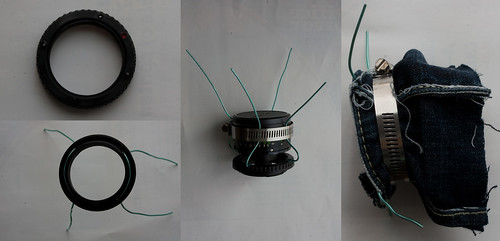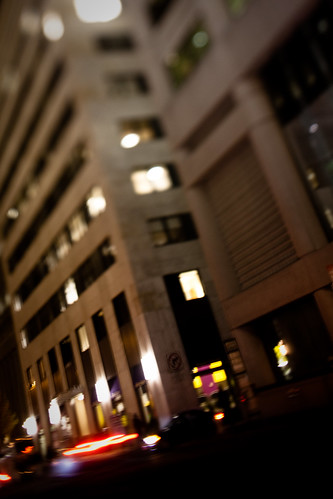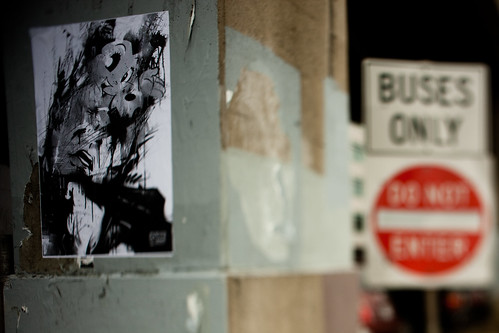So last week I posted up a lengthy description of an experiment I did where I tried building an optical coupler for SLR lenses and camera phones. The post got reposted to a bunch of the major geek and regular news websites and about a zillion people dropped by to have a look.
A bunch of really interesting technical discussions and observations arose out of the whole thing, and for those folks involved (you know who you are) - you're awesome.
So, as demonstrated earlier, I'm a sucker for ugly camera mods. Following up on a discussion I had with the always brilliant fksr a few months ago, I wanted to prototype a revision on my plungercam design that properly allows for both tilt and shift whilst still being being able to be fixed in position for timelapse work.
I had an old 28mm minolta lens lying about that seemed perfect for the job. It isn't a medium format lens, so the issue arose of getting it close enough to the camera sensor so we can do tilt and shift motions. In breaking with my principle of not disassembling lenses, I removed the f-stop adjustment mechanism at the back of the lens (above) so that the back end of it could comfortably fit inside the lens aperture on the camera.
The next bit is the awesome part that fksr proposed. Instead of attaching the lens to the body by using a tube, use some sort of strut mechanism that allows the lens to be posed into position. By just using stiff wire, you can move the lens to almost anywhere you like.
I took a body cap and as per usual cut out the middle of it. I then added four small holes around the edge of the cap that wire could be threaded through. Using two lengths of wire, I added four struts. To test that it worked, I clamped the newly stripped-down lens to the struts using the classic metal plumbing clip. To keep light tight and to (mostly) protect it from the elements, I added a denim sleeve.
This new mechanism allows for both tilt and, significantly, shift movements. To adjust the lens, you just pull on the kinks on the wire until it is posed into the position you desire.
I haven't had a chance to systematically test the shift movements yet; the upcoming bad weather is going to be a bit of a damper on my plans to run about and do some shooting. However, I was able to do some casual shooting earlier on in the week with it.
The two big advantages it seems to have so far: the control of focus is much more subtle, leading to the in-focus areas being much sharper than the original, and the wide field of view. Further testing and prototyping is in-progress :)




3 comments:
Wow! Great great way of doing it. I love the solution you guys came up with. Thanks a lot for sharing!
Hey, so, since you removed the f-stop mechanism, did you retain the diaphragm? And, as I presume that you did, how do you adjust the f-stops now? Oh, and how's the dust level of this version of the plungercam? Friking brilliant, btw.
@Schwoom: the diaphragm is gone, and when the back is gone from the lens, I've just chocked the f-stop to be open the whole way all the time (I'm madly in love with shallow DOF).
Dust-level: not too bad, but it's hard to know for sure. Once the lens is on, it's not too bad. I've also augmented the denim with a large piece of plastic sheeting which provides a better weather seal.
Post a Comment